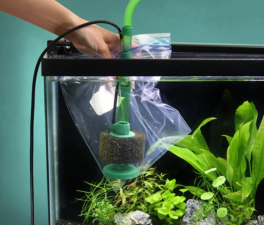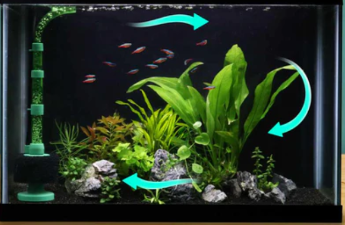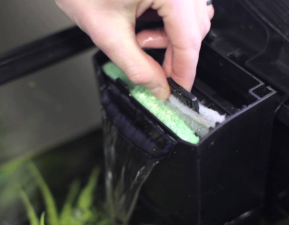In the process of fish farming, the selection, installation and maintenance of the fish tank filtration system are crucial links. An efficient and reasonable filtration system can not only keep the water clear and stable, but also provide a healthy and comfortable living environment for the fish.



In the process of fish farming, the selection, installation and maintenance of the fish tank filtration system are crucial links. An efficient and reasonable filtration system can not only keep the water clear and stable, but also provide a healthy and comfortable living environment for the fish.
Selection and installation of fish tank filtration system

Types of filtration systems
There are many types of fish tank filtration systems, each with its own unique advantages and applicable scenarios. Common filtration systems include bottom tank filtration, trickle filtration, filter barrel, wall-mounted filtration, back filter/side filter, three-in-one filter, air lift filtration, reverse air lift filtration, bottom sand filtration and swamp filtration.
- Bottom tank filtration (bottom filter):
The bottom filter system is suitable for large fish tanks, such as fish tanks over 120 cm. It achieves powerful water purification capabilities by setting additional filter tanks at the bottom of the fish tank and using large space to place more biochemical filter materials. The bottom filter system not only has good filtering effect, but also is easy to maintain, and the filter material can be easily replaced. However, it occupies a large space and is relatively expensive, and is suitable for raising medium and large fish such as arowana and koi.
- Trickle filtration (drip filtration):
The drip filtration system is favored by many people for its high filtration efficiency and simple design. It is usually installed above the fish tank, and water is pumped to the top of the filter box through a water pump. Under the action of gravity, the water flows through the physical filter material and the biochemical filter material in turn, and finally flows back to the fish tank. The drip filtration system has high water purification efficiency, flexible design, suitable for DIY, and affordable price. However, attention should be paid to the load-bearing capacity of the fish tank, because multi-layer drip filtration will increase the load of the fish tank.
- Filter barrel:
The filter barrel is known for its airtightness and beauty, and is particularly suitable for grass tanks. It occupies a small area and is easy to hide, but the oxygenation capacity is limited and the price is relatively high. The filter barrel is suitable for fish tanks of about 100 cm. It is relatively easy to take care of and maintain, but it is necessary to prevent carbon dioxide from escaping. It is not suitable for fish tanks that mainly raise fish.
- Wall-mounted filtration:
The wall-mounted filtration is small and beautiful, cheap, but the filtration capacity is limited, and there is a noise problem. It is suitable for small tanks, few fish, or as an auxiliary filtration. During installation, pay attention to the anti-suction device at the water pump inlet to prevent small fish from being sucked into the filter.
- Back filter/side filter:
Both the back filter and the side filter are built-in filter systems, which use the back or side of the fish tank to separate part of the space as a filter tank. They save external space, but the filtering effect is average, and they occupy the internal space of the fish tank, affecting the viewing effect. Suitable for fish tanks with limited space.

Installation of the filter system
Before installing the filter system, you need to choose a suitable filter system according to the size of the fish tank, the species of fish and the breeding needs. During the installation process, pay attention to the following points:
- Location selection: Make sure that the filter system is installed in a stable position to avoid shaking and water leakage. The bottom filter system should be placed at the bottom of the fish tank cabinet and ensure that the pipe connection is tight. The wall-mounted filter needs to be hung in a stable position on the wall of the fish tank.
- Pipe connection: Carefully check whether all pipe connections are firm to prevent water leakage. For the bottom filter system, ensure that the connection between the inlet and outlet pipes and the fish tank and the filter tank is well sealed.
- Filter material placement: Place the filter material reasonably according to the direction of water flow. Generally speaking, the physical filter layer (such as filter cotton) should be placed in the front to block insoluble impurities; the biochemical filter layer (such as ceramic rings, biochemical balls) should be placed at the back to provide attachment space for nitrifying bacteria.
- Power supply access: Ensure that electrical equipment such as water pumps are connected to a stable power supply and install leakage protection devices.
- Debugging and operation: After the installation is completed, turn on the water pump for debugging. Observe whether the water flow is smooth and whether there is any leakage. At the same time, pay attention to noise control to ensure that it will not interfere with the living environment.

Replacement cycle of fish tank filter cotton
As the first line of defense of the filtration system, the replacement cycle of fish tank filter cotton is crucial to maintaining water quality. However, the replacement cycle is not fixed, but is affected by many factors, including the material of the filter cotton, the breeding density of the fish tank, the amount of feeding, and daily maintenance.
- Material factors
Synthetic fiber: Most fish tank filter cotton is made of synthetic fiber, and its service life is about one month. This type of filter cotton is relatively cheap, but the water filtration quality gradually decreases over time and needs to be replaced regularly.
Polyester foam: The filter cotton of polyester foam material has a long service life and should be replaced about every three months. Its filtering effect is stable and suitable for long-term use.
Biochemical cotton: The filter cotton of biochemical cotton material is more expensive, but has strong filtering ability and long service life. It can usually be replaced every six months.
- Breeding density and feeding amount
The breeding density and feeding amount in the fish tank directly affect the degree of water pollution. If there are a large number of fish in the fish tank or the feeding is frequent, the load of the filter cotton will increase and the replacement cycle needs to be shortened. On the contrary, if the breeding density is low and the feeding amount is small, the replacement cycle can be appropriately extended.
- Observation and judgment
In addition to judging the replacement cycle based on the material and breeding density, you can also decide whether to replace it by observing the state of the filter cotton. If the filter cotton becomes very thin, the water filtering ability is significantly reduced, or it cannot be restored to its original state after cleaning, a new filter cotton should be replaced in time.
- Regular cleaning
In addition to regularly replacing the filter cotton, the filter cotton needs to be cleaned regularly. When cleaning, you can use clean water to gently rinse the surface impurities and avoid rubbing hard to avoid damaging the fiber structure. After cleaning, it should be dried before reinstalling and using.
The installation and maintenance of the fish tank filtration system is an important part of the fish farming process. By selecting the right filter, correctly installing the filter material, adjusting the water flow and aeration volume, etc., the water quality of the fish tank can be kept clean and the fish healthy. At the same time, according to the material of the filter cotton, the breeding density and the feeding amount, the replacement cycle can be reasonably determined, and the filter cotton can be cleaned and maintained regularly, which can extend the service life of the filtration system and keep it running efficiently. I hope that the introduction of this article can provide useful reference and help for fish lovers.



